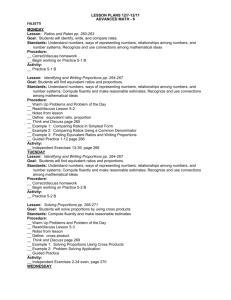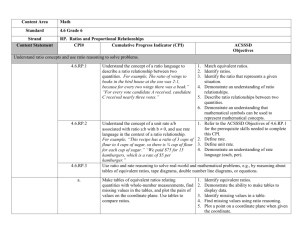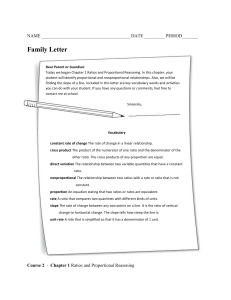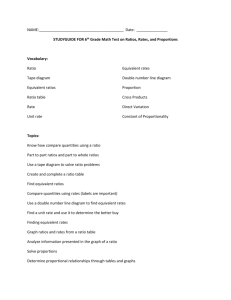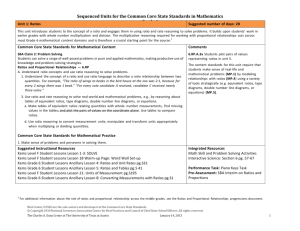West-Orange Cove ISD6th Grade Mathematics – 3rd Six
advertisement
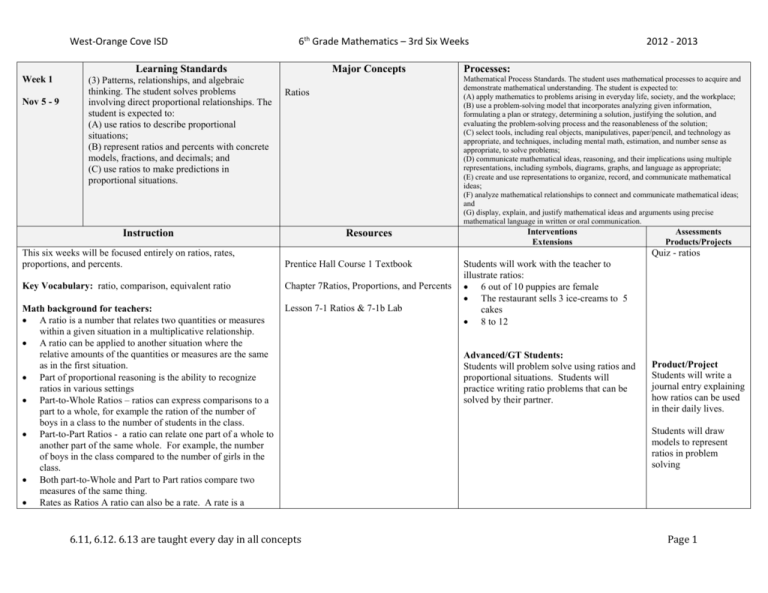
West-Orange Cove ISD 6th Grade Mathematics – 3rd Six Weeks Learning Standards Week 1 Nov 5 - 9 (3) Patterns, relationships, and algebraic thinking. The student solves problems involving direct proportional relationships. The student is expected to: (A) use ratios to describe proportional situations; (B) represent ratios and percents with concrete models, fractions, and decimals; and (C) use ratios to make predictions in proportional situations. Major Concepts Processes: Mathematical Process Standards. The student uses mathematical processes to acquire and demonstrate mathematical understanding. The student is expected to: (A) apply mathematics to problems arising in everyday life, society, and the workplace; (B) use a problem-solving model that incorporates analyzing given information, formulating a plan or strategy, determining a solution, justifying the solution, and evaluating the problem-solving process and the reasonableness of the solution; (C) select tools, including real objects, manipulatives, paper/pencil, and technology as appropriate, and techniques, including mental math, estimation, and number sense as appropriate, to solve problems; (D) communicate mathematical ideas, reasoning, and their implications using multiple representations, including symbols, diagrams, graphs, and language as appropriate; (E) create and use representations to organize, record, and communicate mathematical ideas; (F) analyze mathematical relationships to connect and communicate mathematical ideas; and (G) display, explain, and justify mathematical ideas and arguments using precise mathematical language in written or oral communication. Ratios Instruction 2012 - 2013 Resources This six weeks will be focused entirely on ratios, rates, proportions, and percents. Prentice Hall Course 1 Textbook Key Vocabulary: ratio, comparison, equivalent ratio Chapter 7Ratios, Proportions, and Percents Math background for teachers: A ratio is a number that relates two quantities or measures within a given situation in a multiplicative relationship. A ratio can be applied to another situation where the relative amounts of the quantities or measures are the same as in the first situation. Part of proportional reasoning is the ability to recognize ratios in various settings Part-to-Whole Ratios – ratios can express comparisons to a part to a whole, for example the ration of the number of boys in a class to the number of students in the class. Part-to-Part Ratios - a ratio can relate one part of a whole to another part of the same whole. For example, the number of boys in the class compared to the number of girls in the class. Both part-to-Whole and Part to Part ratios compare two measures of the same thing. Rates as Ratios A ratio can also be a rate. A rate is a Lesson 7-1 Ratios & 7-1b Lab Interventions Extensions Assessments Products/Projects Quiz - ratios 6.11, 6.12. 6.13 are taught every day in all concepts Students will work with the teacher to illustrate ratios: 6 out of 10 puppies are female The restaurant sells 3 ice-creams to 5 cakes 8 to 12 Advanced/GT Students: Students will problem solve using ratios and proportional situations. Students will practice writing ratio problems that can be solved by their partner. Product/Project Students will write a journal entry explaining how ratios can be used in their daily lives. Students will draw models to represent ratios in problem solving Page 1 West-Orange Cove ISD 6th Grade Mathematics – 3rd Six Weeks 2012 - 2013 comparison of the measures of two different things or quantities, the measuring unit is different for each value. For example, if 4 similar boats carry 36 passengers, then the comparison of 4 boats to 36 passengers is a ratio. Boats and passengers are different types of things. The rate would be the passengers per boat. The ratio is written 36:4 or 36/4 or 36 to 4. The rate is 9 passengers per boat. Activity: Partner activity: Provide each group of students with a baggie of different colored manipulatives. Students will write a ratio to describe the blocks in their baggie. Give each partner a small bag of M & Ms. Students will write a ratio to compare the red and brown colored M & Ms. Then decide on 2 other ratios that can be described using their bag of M&Ms. Basic Multiplication Facts: Students should already know basic multiplication facts; however, it is crucial to emphasize the memorization of these facts throughout the entire year 6.11, 6.12. 6.13 are taught every day in all concepts Page 2 West-Orange Cove ISD 6th Grade Mathematics – 3rd Six Weeks Learning Standards Ratios (3) Patterns, relationships, and algebraic thinking. The student solves problems involving direct proportional relationships. The student is expected to: (A) use ratios to describe proportional situations; (B) represent ratios and percents with concrete models, fractions, and decimals; and (C) use ratios to make predictions in proportional situations. Instructional Rates Proportions Resources Key Vocabulary – rate, unit rate, unit cost, proportion, cross products, Prentice Hall Course 1 Textbook: Math background for the teacher: A ratio is a number that relates two quantities or measures within a given situation in a multiplicative relationship. A ratio can be applied to another situation where the relative amounts of the quantities or measures are the same as in the first situation. Part of proportional reasoning is the ability to recognize ratios in various settings Part-to-Whole Ratios – ratios can express comparisons to a part to a whole, for example the ration of the number of boys in a class to the number of students in the class. Part-to-Part Ratios - a ratio can relate one part of a whole to another part of the same whole. For example, the number of boys in the class compared to the number of girls in the class. Both part-to-Whole and Part to Part ratios compare two measures of the same thing. Rates as Ratios A ratio can also be a rate. A rate is a comparison Chapter 7 Ratios, Proportions, and Percents 6.11, 6.12. 6.13 are taught every day in all concepts Processes: Major Concepts Week 2 & 3 Nov 12 – 16 Nov 26 - 30 2012 - 2013 Lesson 7-2 Unit Rates Lesson 7-3 Understanding Proportions Lesson 7 – 4 Solving Proportions Lesson 7-5 Scale Drawings Mathematical Process Standards. The student uses mathematical processes to acquire and demonstrate mathematical understanding. The student is expected to: (A) apply mathematics to problems arising in everyday life, society, and the workplace; (B) use a problem-solving model that incorporates analyzing given information, formulating a plan or strategy, determining a solution, justifying the solution, and evaluating the problem-solving process and the reasonableness of the solution; (C) select tools, including real objects, manipulatives, paper/pencil, and technology as appropriate, and techniques, including mental math, estimation, and number sense as appropriate, to solve problems; (D) communicate mathematical ideas, reasoning, and their implications using multiple representations, including symbols, diagrams, graphs, and language as appropriate; (E) create and use representations to organize, record, and communicate mathematical ideas; (F) analyze mathematical relationships to connect and communicate mathematical ideas; and (G) display, explain, and justify mathematical ideas and arguments using precise mathematical language in written or oral communication. Interventions Extensions Students will complete the ratio table and justify their thinking: Hrs $ 1 5 4 Assessment Formal assessment ratio, rates, proportions 6 10 35 Explain why 5/6 and 25/30 is a proportion. Advanced/GT Students: Students will used advanced problem solving skills to solve ratios and proportional measurement problems. Product/Project Journal entry: Explain how you can use fractions in simplest form to tell that 10/40 and 25/100 form a proportion. Page 3 West-Orange Cove ISD 6th Grade Mathematics – 3rd Six Weeks 2012 - 2013 of the measures of two different things or quantities, the measuring unit is different for each value. For example, if 4 similar boats carry 36 passengers, then the comparison of 4 boats to 36 passengers is a ratio. Boats and passengers are different types of things. The rate would be the passengers per boat. The ratio is written 36:4 or 36/4 or 36 to 4. The rate is 9 passengers per boat. Proportional reasoning is both a qualitative and quantitative process. o It involves an understanding of relationships in which two quantities vary together and are how the variation in one coincides with the variation in another. o Proportional relationships are distinct from nonproportional relationships o It requires a wide variety of strategies for solving proportions or comparing ratios must of which are based on informal strategies rather than traditional algorithms. o Ratios are distinct entities representing a relationship different from the quantities they compare. o Proportional reasoning is used in problem solving to find unknown values. o Knowledge of one ration can be used to find a value in the other. For example, comparison pricing, scales on maps, and percentage problems. Basic Multiplication Facts: Students should already know basic multiplication facts; however, it is crucial to emphasize the memorization of these facts throughout the entire year 6.11, 6.12. 6.13 are taught every day in all concepts Page 4 West-Orange Cove ISD Week 4 & 5 6th Grade Mathematics – 3rd Six Weeks Learning Standards Dec 3 – 7 Dec 10 - 14 Major Concepts Ratios (3) Patterns, relationships, and algebraic thinking. The student solves problems involving direct proportional relationships. The student is expected to: (A) use ratios to describe proportional situations; (B) represent ratios and percents with concrete models, fractions, and decimals; and (C) use ratios to make predictions in proportional situations. Instruction Rates Proportions Percents Resources 2012 - 2013 Processes: Mathematical Process Standards. The student uses mathematical processes to acquire and demonstrate mathematical understanding. The student is expected to: (A) apply mathematics to problems arising in everyday life, society, and the workplace; (B) use a problem-solving model that incorporates analyzing given information, formulating a plan or strategy, determining a solution, justifying the solution, and evaluating the problem-solving process and the reasonableness of the solution; (C) select tools, including real objects, manipulatives, paper/pencil, and technology as appropriate, and techniques, including mental math, estimation, and number sense as appropriate, to solve problems; (D) communicate mathematical ideas, reasoning, and their implications using multiple representations, including symbols, diagrams, graphs, and language as appropriate; (E) create and use representations to organize, record, and communicate mathematical ideas; (F) analyze mathematical relationships to connect and communicate mathematical ideas; and (G) display, explain, and justify mathematical ideas and arguments using precise mathematical language in written or oral communication. Interventions Extensions Assessment Key Vocabulary: percent Prentice Hall Course 1 Textbook Math background for the teacher: The term percent is another name for hundredths and as such is a standardized ratio with a denominator of 100. Students should use base 10 fraction models for fractions, decimals, and percents since they all represent the same idea Link students’ thinking to decimals and fractions when teaching percents. Help students see the following exercises as the same types of exercises they did with fractions. Have students to use models or drawing to explain their solutions. Activity: Students will compute and draw illustrations for the following: The PTA reported that 75% of the total number of families was represented at the meeting last night. If children from 320 families go to the school, how many were represented at the meeting? 6.11, 6.12. 6.13 are taught every day in all concepts Chapter 7 Ratios, Proportions, and Percents Lesson 7-6a Lab Lesson 7-6 Percents, Fractions, and Decimals Lesson 7-7 Finding the Percent of a Number Lesson 7-9 Estimating with Percents Students will work in small group with the teacher to model percents using models and or drawings. Advanced/GT Students: Students will write a sales ad and produce a commercial for a savings of a specific percent off of an item. Students will present their commercials. Formal - Percents Products/Project Students will analyze sales ads to calculate the savings on products http://express.smarttech.com/?url=http://exchanged ownloads.smarttech.com/public/content/95/951e316 c-26c0-4001-846646d56657390c/%237%20Percents.notebook# Page 5 West-Orange Cove ISD 6th Grade Mathematics – 3rd Six Weeks 2012 - 2013 The baseball team won 80% of the 25 games it played this year. How many games were lost? In Ms. Hardin’s class, 20 students or 66 2/3% were on the honor roll. How many students are in her class? Tom bought his computer at 12 ½ % discount. He paid $700. How many dollars did he save by buying it at a discount? Basic Multiplication Facts: Students should already know basic multiplication facts; however, it is crucial to emphasize the memorization of these facts throughout the entire year 6.11, 6.12. 6.13 are taught every day in all concepts Page 6 West-Orange Cove ISD 6th Grade Mathematics – 3rd Six Weeks Week 6 Learning Standards: Major Concepts Circle Graphs Dec 17 - 21 (10) Probability and statistics. The student uses statistical representations to analyze data. The student is expected to: (C) sketch circle graphs to display data; and (D) solve problems by collecting, organizing, displaying, and interpreting data. Instruction This week students will learn to use circle graphs and problem solve using ratios and proportions. Problem Solving Resources Prentice Hall Course 1 Textbook Key Vocabulary: Circle graph Most of this week will be review and semester testing that will cover decimals, fractions, ratios, rates, and proportions. After one day of review students will be allowed one and a half class periods for testing. Exams will then be graded and profiled. The data will be used to form small group instruction that meets the needs of all students. Chapter 7 Ratios, Proportions, and Percents Lesson 7-8, 7-8b Lab, Problem Solving (2 days) 2012 - 2013 Processes: Mathematical Process Standards. The student uses mathematical processes to acquire and demonstrate mathematical understanding. The student is expected to: (A) apply mathematics to problems arising in everyday life, society, and the workplace; (B) use a problem-solving model that incorporates analyzing given information, formulating a plan or strategy, determining a solution, justifying the solution, and evaluating the problem-solving process and the reasonableness of the solution; (C) select tools, including real objects, manipulatives, paper/pencil, and technology as appropriate, and techniques, including mental math, estimation, and number sense as appropriate, to solve problems; (D) communicate mathematical ideas, reasoning, and their implications using multiple representations, including symbols, diagrams, graphs, and language as appropriate; (E) create and use representations to organize, record, and communicate mathematical ideas; (F) analyze mathematical relationships to connect and communicate mathematical ideas; and (G) display, explain, and justify mathematical ideas and arguments using precise mathematical language in written or oral communication. Interventions Extensions Assessment Assessments: Teacher will continue small group instruction to ensure students are prepared for the semester exam. Semester review and semester exam Advanced/GT Students: Students will use their homework, classwork, and test data to graph their grades in each category. Semester review (1 day) Semester Exam (2 days) http://express.smarttech. com/?url=http://exchang edownloads.smarttech.c om/public/content/7a/7a a8705c-08ad-461a-971ca02b57b12069/Jeopardy .notebook# 6.11, 6.12. 6.13 are taught every day in all concepts Page 7 West-Orange Cove ISD 6th Grade Mathematics – 3rd Six Weeks 6.11, 6.12. 6.13 are taught every day in all concepts 2012 - 2013 Page 8
